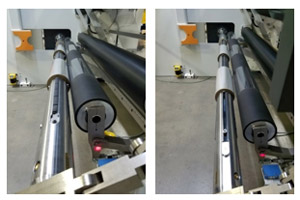

July 26 2017

In a previous article, it was discussed how today’s web converters are challenged with the technology of their older slitter rewinder equipment and that one area where we have seen gains being made is the development of improved lay-on roller systems. Over time lay-on roller technology evolved from simple pivoting support arms, to pneumatically loaded, and then the individual lay-on roller system was introduced. However, these individual lay-on rollers added complexity and room for error due to the difficulty of not knowing how much lay-on nip force to apply. Thus, linearly-acting lay-on roller systems were developed to provide better nip force control.
Linearly-acting lay-on rollers have the benefit of maintaining a constant nip force for a given air pressure by the nature of their constant geometry. Although contact stress does change as roll diameter increases due to a larger contact area at the nip point, much more predictable winding results are realized without complicated calculations. If the desired starting and ending nip forces, along with the length of the lay-on rollers installed in the slitter machine are entered by the operator as set points, then the desired nip profile could now be accurately applied by the machine without empirical testing. For converting operations that must change setups frequently due to processing a variety of materials of various widths and thicknesses, these benefits can go a long way in reducing waste and setup time.
Being able to accurately impart the amount of nip load that ensures the required finished roll quality is one benefit of a direct or linearly-acting lay-on roller system. But how can these systems help when the material being processed responds better when it is not nipped at all?
This non-contact mode is used for nip-sensitive materials such as tapes and label stock with exposed adhesive, materials with high coefficient of friction, or materials with extreme gauge variation. Materials with these characteristics tend to wind better when wound softer, or with less wound-in tension. However, winding soft rolls with a large entry span can produce less than desirable edge profile results. It is therefore beneficial to convey the web as close as possible to the winding point without physically nipping the incoming web to the winding roll. Maintaining a small gap between the lay-on roller and the winding package throughout the roll build is, by definition, winding in minimum gap mode.
There are various ways to accomplish minimum gap, and slitter rewinders with this capability generally use a motorized carriage to track the lay-on assembly away from the building roll as it increases in diameter to maintain the pre-determined gap. Positioning the carriage requires either an accurate real-time diameter calculation or measurement sensor. However, winding multiple lanes of slit material with slight thickness variations on a common shaft makes physical measurement of the diameter impractical. Thus, diameter calculation rather than measurement becomes the preferred method. To ensure accuracy, keeping web lengths and roller geometries constant throughout the roll build allows more precise diameter and length calculations. The advantage is improved winding and web handling performance.
Fundamentally a good lay-on system like the linearly-acting lay-on roller will ensure predictable web tension and lay-on nip controls, whether in contact or minimum gap mode, but are there other advantages?
NEXT ARTICLE IN THE SERIES: Learn more about the advantages of having predictable web tension and lay-on nip controls.